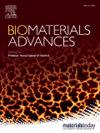Non-antibiotic dependent photothermal antibacterial hemostatic MXene hydrogel for infectious wounds healing
IF 5.5
2区 医学
Q2 MATERIALS SCIENCE, BIOMATERIALS
Materials Science & Engineering C-Materials for Biological Applications
Pub Date : 2024-12-17
DOI:10.1016/j.bioadv.2024.214157
引用次数: 0
Abstract
On account of the existence of antibiotic resistance, the wound healing of pathogenic infection is still a challenge in modern society. A desirable wound dressing should own the abilities of adhesiveness, hemostasis and good mechanical property, meanwhile the property of eliminating bacteria without side effects is also highly needed. In this work, we established a kind of hydrogel based on carboxymethyl cellulose-graft-tyramine (CMC-Ty) and MXene (Ti3C2Tx) through employing H2O2/HRP (horseradish peroxidase) as the initiator, then the as-prepared hydrogel (named CMC-Ty/MXene) was immersed in tannic acid (TA) solution, and this TA-treated hydrogel was called CMC-Ty/MXene+TA. By employing TA as the multi-functional H-bond provider, the adhesiveness, hemostatic ability, mechanical property and bactericidal performance of the hydrogel was enhanced. And MXene in this system exerted benign photothermal antimicrobial performance, it was able to transform near-infrared (NIR) light into heat, then the bacteria would be physically damaged (thermal destruction) due to the hyperthermy, hence the antibacterial effect of which will not be restricted by antibiotic resistance. The temperature of the hydrogel in the experimental group can be increased by 25 °C after irradiation by 808 nm NIR light for 10 min, and the bactericidal efficiency against both E. coli and S. aureus reached >99 %. In vivo tests demonstrated that with the assistance of NIR irradiation, the hydrogel can distinctly accelerate the S. aureus infected wound closure. We envisage that this non-antibiotic dependent multifunctional photothermal hydrogel can provide a promise for bacteria-invaded wound healing.

非抗生素依赖光热抗菌止血MXene水凝胶用于感染性伤口愈合。
由于抗生素耐药性的存在,致病性感染的伤口愈合在现代社会仍然是一个挑战。一种理想的创面敷料应具有粘附性、止血性和良好的力学性能,同时还应具有除菌无副作用的性能。本研究以H2O2/辣根过氧化物酶(HRP)为引发剂,建立了一种羧甲基纤维素-接枝酪胺(CMC-Ty)和MXene (Ti3C2Tx)为基础的水凝胶,将制备的水凝胶(命名为CMC-Ty/MXene)浸入单宁酸(TA)溶液中,经TA处理后的水凝胶称为CMC-Ty/MXene+TA。利用TA作为多功能氢键提供者,提高了水凝胶的黏附性、止血能力、力学性能和杀菌性能。该体系中的MXene具有良好的光热抗菌性能,它能够将近红外(NIR)光转化为热,然后细菌会因高温而受到物理损伤(热破坏),因此其抗菌效果不会受到抗生素耐药性的限制。实验组水凝胶经808 nm近红外光照射10 min后,温度可提高25℃,对大肠杆菌和金黄色葡萄球菌的杀菌效率均达到99.9%。体内实验表明,在近红外照射的辅助下,水凝胶可以明显加速金黄色葡萄球菌感染的伤口愈合。我们设想这种不依赖抗生素的多功能光热水凝胶可以为细菌入侵的伤口愈合提供希望。
本文章由计算机程序翻译,如有差异,请以英文原文为准。
求助全文
约1分钟内获得全文
求助全文
来源期刊
CiteScore
17.80
自引率
0.00%
发文量
501
审稿时长
27 days
期刊介绍:
Biomaterials Advances, previously known as Materials Science and Engineering: C-Materials for Biological Applications (P-ISSN: 0928-4931, E-ISSN: 1873-0191). Includes topics at the interface of the biomedical sciences and materials engineering. These topics include:
• Bioinspired and biomimetic materials for medical applications
• Materials of biological origin for medical applications
• Materials for "active" medical applications
• Self-assembling and self-healing materials for medical applications
• "Smart" (i.e., stimulus-response) materials for medical applications
• Ceramic, metallic, polymeric, and composite materials for medical applications
• Materials for in vivo sensing
• Materials for in vivo imaging
• Materials for delivery of pharmacologic agents and vaccines
• Novel approaches for characterizing and modeling materials for medical applications
Manuscripts on biological topics without a materials science component, or manuscripts on materials science without biological applications, will not be considered for publication in Materials Science and Engineering C. New submissions are first assessed for language, scope and originality (plagiarism check) and can be desk rejected before review if they need English language improvements, are out of scope or present excessive duplication with published sources.
Biomaterials Advances sits within Elsevier''s biomaterials science portfolio alongside Biomaterials, Materials Today Bio and Biomaterials and Biosystems. As part of the broader Materials Today family, Biomaterials Advances offers authors rigorous peer review, rapid decisions, and high visibility. We look forward to receiving your submissions!
文献相关原料
公司名称
产品信息
阿拉丁
tannic acid (TA)
阿拉丁
lithium fluoride (LiF)
阿拉丁
N-Hydroxysuccinimide (NHS)
阿拉丁
1-ethyl-3-(3-dimethylaminopropyl) carbodiimide hydrochloride (EDC)
阿拉丁
Carboxymethyl cellulose (CMC)
阿拉丁
horseradish peroxidase (HRP)
阿拉丁
tannic acid (TA)
阿拉丁
lithium fluoride (LiF)
阿拉丁
N-Hydroxysuccinimide (NHS)
阿拉丁
1-ethyl-3-(3-dimethylaminopropyl) carbodiimide hydrochloride (EDC)
阿拉丁
tyramine hydrochloride
阿拉丁
Carboxymethyl cellulose (CMC)
阿拉丁
horseradish peroxidase (HRP)

 求助内容:
求助内容: 应助结果提醒方式:
应助结果提醒方式:


